Computer equipment and digital technology can seem foreign and alienating to those not accustomed to using computers for more than word processing and e-mail. Artists use computer software and hardware as platforms for a range of aesthetic activities. Their equipment can include everything from desktop or laptop computers and personal digital assistants to joysticks, touch screens, and sensors. Because every artwork is unique, determining the necessary system requirements for computer-based art can be tricky. Some projects might call for defunct hardware or software, while others might require sophisticated operating systems and high-speed Internet connections. There are also environmental specifications to consider. Increasingly, computer-based projects are migrating from the static computer screen onto the walls of the gallery. As the lines between single-channel video, media installations, and computer-based works continue to blur, the technological guidelines and specifications overlap as well.
This section does not intend to be a comprehensive
list of all the technical elements of new-media or computer-based
art works, but rather a guide to the basic hardware, software,
and network attributes that are used in the installation of
many computer-based artworks. It is advisable to visit the Single-Channel
and the Installation
Equipment & Technical Issues sections for a comprehensive understanding
of the equipment and technical specifications one may encounter
when collecting computer-based works.
The complex nature of digital artworks means that the risks posed by equipment are varied and many. For a discussion of the risks (including failure and obsolescence) that can affect the various components of computer-based art in different ways, please see the Equipment/Technical issues in the Preservation section of this guide.
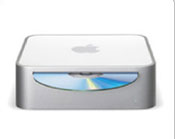
Mac mini
|
|
Mac mini is the least expensive Macintosh
currently in production and is very useful for media installations.
|

iMac |
|
iMac. The iMac is a common
desktop computer.
|
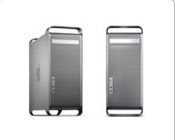
PowerMac |
|
PowerMac The PowerMac is
the most expensive, and potentially powerful model.
|
|
PC: Although the term PC (short for Personal
Computer) is broad enough to include Apple computers as
well as others, the term is commonly accepted to mean
“IBM compatible,” which today means Windows
machines. PCs have numerous manufacturers, unlike Apple.
These manufacturers include Dell, HP, Compaq, Sony.
Servers
Video Server
Just as DVD replaced VHS and Laserdisc for showing video
in art spaces, computers are replacing DVD. When a computer
is set up with the sole purpose of playing video, this
computer is called a Video server, and it can be assembled
from a general-purpose computer like a Mac or Windows
PC or it can be manufactured as a stand-alone device,
like a DVD player. The advantage of a video server is
its ability to play many types of video, including HD
(high-definition).
Network Server
See Network section below. |
Input Device
Input devices allow a user to interact with the computer.
What kind of input device to use (if not specified by
the artist) depends on what level of interaction is necessary
to animate the work successfully. Some common input devices
are:
|
 |
|
Mouse/keyboard. These are
the two main input devices for computer installations. The
mouse allows for basic “point and click” interaction
and the keyboard allows for more traditional input like
text entry.
|
| |
|
Touch Screens. Touch screens overlay
the display and are typically pressure-sensitive (resistive),
electrically-sensitive (capacitive), acoustically-sensitive
(SAW or surface acoustic wave) or photo-sensitive (infrared).
For simple interactions, these devices replace the keyboard
and/or mouse as the primary input device for interacting
with a work’s content.
|
| |
|
Image/Video/Audio. Scanners, digital
cameras and camcorders, Webcams and microphones all can
be used as input devices for computer based installations,
not only as an input for image and sound, but as a way to
track a user’s movement through space.
|
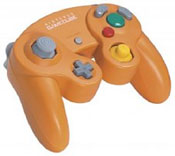 |
|
Gaming Devices. Common video
game inputs are sometimes used in installations, such as
joysticks, paddle, and game pads. |
Output Device
An output device is any display mechanism that is controlled
by a computer. Common display devices include projectors,
video and audio monitors. Hard drive playback is an attractive
alternative to formats that are unreliable or insist on
high compression levels.
|
Connections and
Cables
Connections and cables are devices for moving analog and
digital data in and out of the computer. Some are computer
specific and others come from traditional AV connection
types.
|
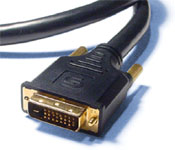
DVI |
|
DVI/HDMI is the standard display output
of contemporary computers, which transfers video from the
computer to the display digitally. Since most of today’s
displays (projectors, flat screens) are digital, DVI avoids
the digital-to-analog (DA) conversion required if a VGA
connection is used (see VGA below). HDMI transfers the video
picture the same way as DVI but also includes multiple digital
audio channels for surround sound. HDMI is becoming the
consumer standard as it is adopted by home theater devices.
|
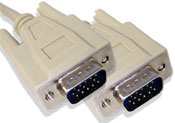 |
|
VGA is an analog cable commonly
used to connect a computer to a display. VGA accomodates
a screen resolution of 640 x 480 pixels. Other resolutions
include SVGA = 800 x 600; XGA = 1024 x 768; WXGA = 1280
x 768 (widescreen display); SXGA = 1280 x 1024; UXGA = 1600
x 1200.
|
 |
|
DVI to VGA adaptor. Most
older projectors only have VGA inputs, while many new computers
are only equipped with a DVI output. A DVI to VGA adaptor
is a common connector used (especially for Macintosh users)
to remedy this incompatibility.
|
| |
|
Balanced and Unbalanced Audio. Balanced
connections are used in pro environments because the twisted-pair
structure of a balanced cable reduces potential noise interference.
Unbalanced is by far the more common. These connections
can use the same RCA cable and connector used in home video
and audio equipment, and also commonly seen connecting to
a computer with 1/8” mini connector, like those found
on headphones for MP3 players.
|

|
|
USB (Universal Serial Bus) is a common
interface for connecting external devices to computers.
USB cables can be daisy-chained together from one origin
at the computer to connect multiple devices .
|
 |
|
FireWire (IEEE 1394). FireWire is a replacement
for SCSI (small computer system interface) that commonly
connected older PCs to printers and other external devices.
Firewire has become the standard for transferring digital
video. |
Software
From e-mail to word processing, software is what allows
the computer to perform specific functions. In this section,
only software that is related to exhibition and playback
of artist content will be covered.
Operating Systems
Operating systems are software programs that load and
run other programs. In general-purpose operating systems
like Windows, Mac OS and Linux, the operating system is
required to allow all the applications anyone might install
on their computer to communicate with each other and with
the hardware.
|

|
|
Windows. Microsoft’s
is the most widely installed OS. The current version is
Windows XP. |
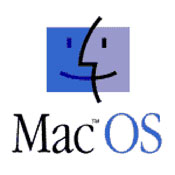
|
|
Mac OS. The current OS for
Macintosh is OS X. |
 |
|
Linux. Unlike Windows or
Mac OS, Linux is an open source operating system, meaning
that the underlying code is freely available for anyone
to view, copy or modify. |
|
Application Software
Application software describes a loosely defined subclass
of software which employs the OS of a computer directly
to a task. Typical examples of software applications include
word processors, e-mail programs, and media players.
Browsers
The term browser refers to software that allows one to
browse the World Wide Web. Depending on the needs of the
project, different browsers work better for different
playback formats.
|

|
|
Internet Explorer is a proprietary
Web browser made by Microsoft and included as part of Windows
operating systems. |

|
|
Safari is a Web browser
developed by Apple Computer Inc. and available as part of
its OS X operating system. |
 |
|
Mozilla Firefox is a free,
open source, cross-platform web browser developed by the
Mozilla Corporation and hundreds of volunteers. |
|
Video/Audio Playback
Video and audio exist on a computer as files, and these
files use a compression/decompression scheme (Codec) to
organize the data. These files could be a movie on a DVD,
a clip downloaded from a Web site, or an MP3. A file holds
the data for that particular piece of media but in order
to view or hear it you’ll need a media player, which
is analogous to a set-top DVD player (but capable of far
greater versatility). Media players play back many kinds
of media files. Common media players are QuickTime, Windows
Media Player, RealPlayer, iTunes, and numerous other commercial
players and shareware players.
Codecs
The amount of data contained in a native video or audio
file can be large enough to make playing it, using it,
or downloading it impossible or impractical on any but
a very fast computer with enormous storage. When a file
size is reduced through compression, information is removed,
resulting in a file that can’t fully reproduce the
original picture/sound information (lossy compression).
To use a compressed file it must be decompressed by the
hardware or software. This procedure of compressing and
decompressing data by using algorithms is called a Codec.
The following is a list of common codecs.
Video codecs include:
Quicktime: The default container codec
for Apple operating systems.
AVI: The default container codec for
Windows operating systems.
Mpeg (Moving Pictures Expert Group):
By storing only the changes from one frame to another,
instead of each entire frame, MPEG can be a highly compressed
format. There are three major MPEG standards: MPEG-1,
MPEG-2 and MPEG-4. MPEG-2 is the codec used for DVD videos.
WMV H.264: a version of MPEG-4 being
adopted in a wide array of applications including HD-DVD/Blu-ray
and iTunes video.
Audio Codecs include:
WAV: Standard Microsoft audio file format
for storing audio on Windows machines.
AIFF (Audio Interchange File Format):
Standard audio file format for storing and playing sound
data on Macintosh computers.
MP3: the audio component of the MPEG-3
codec but used only for audio.
MIDI: Bitstream encoding that can be
thought of as instructions which tell a music synthesizer
how to play a piece of music. An important attribute of
early Web style, it is no longer supported by web browsers
other than Internet Explorer.
|
Networks
The following are common components that are found in networks:
Servers: a large computer or series of
computers designed for applications serving client computers
with data over a LAN or WAN.
Router: a dedicated computer that sends
packets of information from one place to another.
IP (Internet Protocol): The address of
a computer on a TCP/IP (transmission control protocol/internet
protocol) network. IP addresses are written as four groups
of up to three digits.
POP (Post Office Protocol). POP is a
way of retrieving mail from an e-mail server (POP server).
Firewall: A hardware or software system
designed to limit access to a computer or a network. Firewalls
protect computers from unwanted data coming into the system
via the Internet. It can also stop information from getting
out, which can be a problem for some artists’ projects.
FTP (File Transfer Protocol): standard
protocol for transferring files between computers over
the Internet.
Streaming Media: Media that is consumed
while it is being delivered. This method transfers data
in a steady and continuous stream.
Bluetooth: a wireless standard that allows
devices like personal digital assistants (PDA), mobile
phones, laptops, phones, and digital cameras to communicate
with each other, but only within a 10 meter area. (Bluetooth
is named after the Danish king Harold Bluetooth, who united
area tribes through diplomacy.)
LAN or WAN: a Local
Area Network (LAN) is used for home, office or building
sized computer networks. A LAN can be as small as two
computers sharing a printer and/or an Internet connection,
even if they are using a wireless connection. Wide Area
Networks (WAN) consist of many computers across a large
area, the Internet being an example. WAN can also connect
LANs to one another.
Cable, DSL: Cable and
DSL are technologies in use in homes and small offices,
which allow a computer or a LAN to connect to the Internet.
Cable uses the same connection as cable television; Digital
Subscriber Line (DSL) uses the phone line.
|
